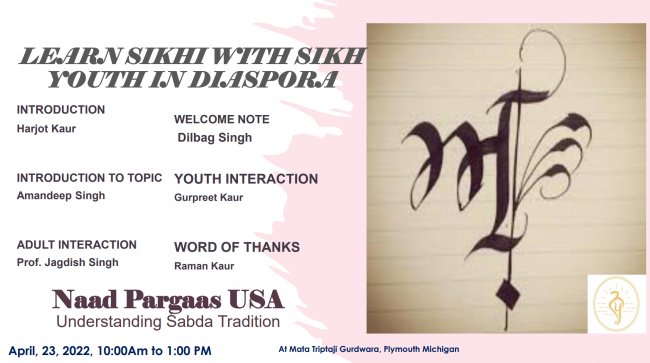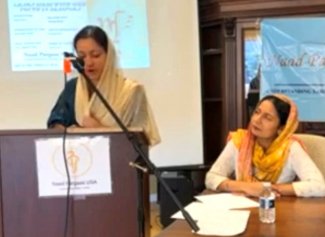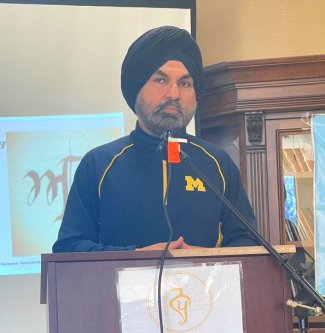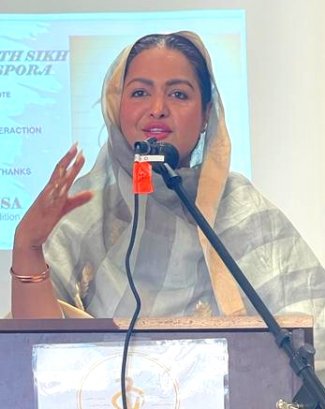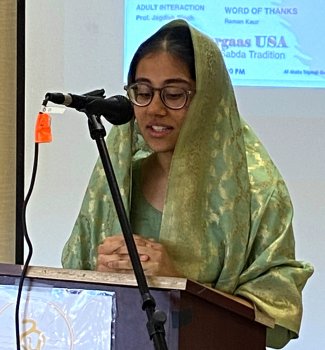April 23,2022, Plymouth Michigan
A workshop with Sikh Youth and parents was organized by Naad Pargaas USA at Mata Triptaji Gurdwara in Plymouth Michigan. Commenting on the theme of the workshop, Harjot Kaur, Convener Naad Pargaas USA, said that the civilizational models of any community are primarily defined by the epistemological and spiritual pursuits that a community endeavors to produce. She said that working with the Sikh Youth and parents among the migrant populations was an effort in the direction of learning conceptual understandings of Sikhi.
The program started with a lecture from Amandeep Singh, Director Naad Pargaas USA. He said that because of a vacuum of a spiritual and cultural tradition in diasporic spaces, the youth remain in a state of psychological dilemma. The first-generation immigrants brought the spiritual tradition from their origin, primarily from Punjab. However, by remaining focused primarily on their economic prosperity, the natural inclination within Sikhs, that could produce Sikh culture in the west, got neglected. This has led to negligible interests in producing Sikh literature, Sikh symbolism, poetry, culture and other art forms within their new homes, that eventually conditioned Sikh imagination and deferred one’s connection with the Sikh tradition and Śabda philosophy. With minimal engagements in creative pursuits, Sikhs have ended up in building closed spaces within open societies, while consistently nurturing their imagination with political and economic issues of Punjab. This has led to a systematic displacement of youth towards cultural perplexities, who are ill equipped to deal externally with the identity crisis in the secular world and internally with growing issues of mental health. To realize a universal world view of Sikhi in the West, the youth should endeavor to build cultural bridges while creating new patterns of thinking and traditions by cultivating creative pursuits in art, language, literature, culture and aesthetics. However, he cautioned that unreflective borrowing of conceptual ideas and ethics from the secular modes of thinking could also lead Sikh youth to assert pressure on Sikhi that can further produce problems within Sikh realization.
The lecture was followed by short talks from participating Sikh Youth. Ania Kaur, shared her experience of Camp Khalsa that she said was helpful in discovering her understanding of Sikh concepts and relating with Sikh identity. Harjot Singh expressed his wish to know the philosophy of different religions so he could better understand and validate his choice. He expressed his thoughts to build relationships in liberal and open societies. Harnoor Singh delved into understanding the importance of Sangat to realize the higher meaning of Sikhi. Mentioning his personal experience he felt that the Sikh camps were instrumental in propagating the formation of Sangat that was instrumental in cultivating a collective spiritual journey of Sikhs.
While questioning the prevalent phenomenon of judging intelligence with academic grades and professional careers, Uday Singh quizzed the lens that has overshadowed Sikh parents to relate spiritual growth with materialistic achievements. While commenting on the translations of Śabdas in Dewan Halls of Gurdwaras, Guneet Kaur felt that there was some component that was missing that did not let her go deeper than a surface understanding of Gurbani. Jasnoor Kaur talked about the Sakhi tradition and narrated her personal experiences how she would relate with the Guru period and the Gurus listening to Sakhis during her childhood. She said it would be good if Sakhis could be written creatively in the west to make her relate with the Sakhi tradition.
Daman Gill, Imaan Kaur and Maheep Singh shared their experiences through video messages. Daman Gill shared her distasteful experiences of bullying at her school primarily because of her identity as a Sikh. She expressed her estrangement with orthodoxic closeness of the community and how a proper Sikh behavior was codified that has led to ignoring of important issues like that of mental health. Imaan Kaur expected Gurdwaras to provide safe space to question the practices so that the youth could relate with Sikh practices. She emphasized the need to develop intellectual culture among Sikhs and to promote research in Sikh subjects rather than setting norms that could become dogmatic. Maheep Singh expressed a practical need to set up rides from the universities and local colleges, so Sikh youth could attend Gurdwaras more often. The session was coordinated by Gurpreet Kaur who encouraged the young participants to raise their issues so thoughtful solutions could be produced from within the community.
In the second half inputs were taken from the parents. Participating parents expressed their satisfaction and the enthusiasm to know how the kids in the diaspora were relating with Sikhi. They were also enthusiastic to continue these exercises further. Jaspreet Singh expressed his gratitude for an eye-opening session and input from the youth. He said that the next generation learns by example and that there could perhaps be a separate divan in Gurudwara for youth to relate with Sikhi in their own language. Having been raised and brought up in the West, Raman Singh narrated her personal experience while growing up in Michigan. She acknowledged the perplexities of diasporic youth and how she could personally relate with the inputs that were received from the youth.
She also narrated the story of Sikh immigration in Michigan and mentioned that 2022 was the 100th year since the Sikhs first came to Michigan. Attending the workshop, Balbir Singh from Toronto, Canada, said that understanding Gurbani was not a given thing even back in India. However, relating with Gurbani was primarily an experience of realization for which a culture needs to be developed with the support from scholars. Understanding the challenges of youth in the West, Jasvir Singh noted the vacuum of tradition and culture within the west. He said that with that vacuum the mind cannot be enlightened, and the issues of the youth shall continue to remain buried under the rug.
Jasvin Sidhu was touched with inputs that the youth shared that she thought challenged the belief systems of parents and society. She said that it was important to accept the next generation with open mind as the society in the west was more individualistic and required a transfusion of ideas between traditional and Western culture without preset judgements. Gagandeep Singh was the last parent who shared his personal experience to explain that in open societies it was not just a one way flow where a parent dictates terms to next generation, rather it was possible for the next generation to dismantle the preset mindset of elder generations making it possible for elder generation to learn from new generation. Many parents realized that their blind pursuits for economic interests was a mistake and that therefore, there was a need to involve further in spiritual pursuits.
The session was concluded by a lecture from Prof Jagdish Singh. Building upon the feedback from parents and younger generation he said that Sikhs in the West need to migrate ‘authentically’ in order to realize the universal nature of Sikhi. He pointed out that youth should realize that the first generation of Sikhs brought Sikhi with them and they built Gurdwaras that helped the next generation to initiate a connection with Sikhi. He mentioned that the culture of analytical understanding of Gurbani (that the younger generation has unconsciously borrowed from the secular world of the west) can be productive only to reflect upon the cognizable meaning of Gurbani that appeals primarily to one’s analytical mind. However, for self-realization and higher experience, it was indispensable to go beyond analytical understanding and realize Gurbani as a part of one’s physical body.
This was a reason that Sikh tradition has cultivated a culture of memorizing Gurbani and simultaneously understanding its meaning in Kathas. Gurdwaras have provided the spaces for imbibing the images of Sikh culture and making perceptions that creates an environment for internalization of Sikh traditions. So it was vital to build upon what has been made available and therefore, it was high time for Sikhs to develop their research centers that can help relate the sign systems, symbolic forms, natural landscapes, cultural archetypes and language of the West (English) with the Guru language.
The program was live streamed and was attended by participants across the globe. Naad Pargaas USA is striving to start a research center for Sikhs in the USA and appealed to Sangat for their support. For more information visit https://naadpargaasusa.com

